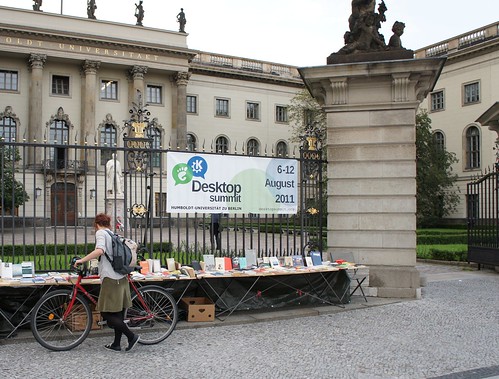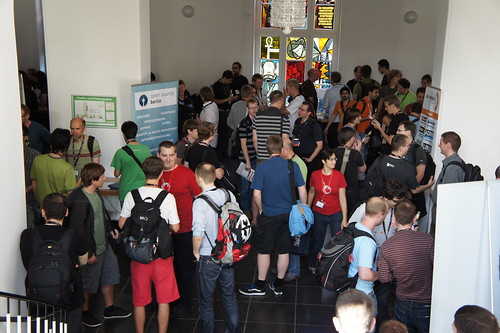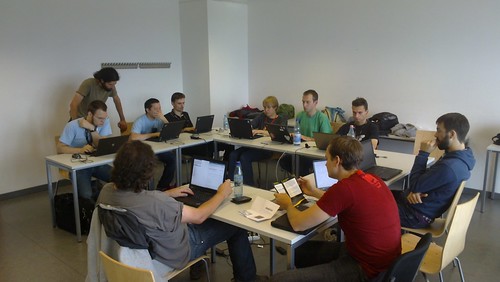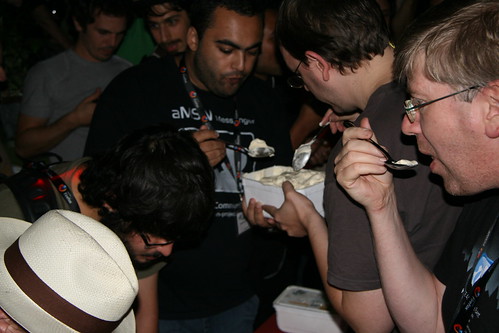For the second and third full days at the Desktop Summit, the organizers played a little trick on us by starting talks at 9:00 a.m. Those who were awake enough after the dinners and chat of the previous night were treated to talks on Calligra (the KDE creativity and productivity suite), suggestions about blending the web and the desktop, color management and the build process for GNOME. Those who were still in bed will have to wait for the videos and slides to be posted online in the next few days.
As the mornings went on the attendance at talks increased noticeably. Sunday was also the day of the press conference, where key figures from GNOME, KDE and the cross-community organizing team met with the press to answer their questions about the event and the future of free software. Sunday night ended with a Beach Party. On Monday the day started similarly slowly but quickly picked up. The keynotes and closing sessions attracted pretty much everyone and the day was finished off by a soccer and volleyball match.

Keynotes
To read up on the keynotes and, please go to the desktopsummit.org news page. There you will find write-ups on the keynote by Claire Rowland on getting our stuff everywhere, the GNOME community keynote by Nick Richards on user interface design, all about toasters by Thomas Thwaites and more.
GNOME AGM
The GNOME AGM was led by our new Executive Director, Karen Sandler. It was kicked off by a number of update presentations, from which you can find some notes below.
Andre Klapper reported on both the release team and the bug squad. The GNOME 3 release was the big news regarding release, along with some discussions about the bumps along the way. Jon McCann and Calum Benson also gave a report from the Design team about the redesign aspects of the GNOME 3 release.
From the Bug Squad, top bug closers were Akhil Laddha, Fabio Durán Verdugo, Matthias Clasen and Bastien Nocera. Top bug reporters were Akhil Laddha, Bastien Nocera, Matthias Clasen and Guillaume Desmottes. The top ten patch contributors were Milan Crha, Colin Walters, Dan Winship and Florian Müllner. The top patch reviewers were Owen Taylor, Dan Winship, Sebastian Dröge and Matthias Clasen.
Alejandro Piñeiro gave an update on accessibility and the challenges in moving to GNOME 3. Stormy Peters gave an update on behalf of the marketing team.
Juan José Sánchez Penas from Igalia gave a report on the integration of the Maemo code into GTK. They discovered that especially blogging about it lead to lots of input and comments from the community which was very helpful! A major bump was that the community was very busy with the work on GNOME3 and GTK3 so there was quite a delay in getting patches reviewed and merged.
Vinicius and Andreas Nilson talked about the big news of our new website and the work it took to get that finally done.

Petr Kovar reported on localization, Shaun McCance updated everyone on the state of our documentation and Emily Chen discussed the GNOME events, which included 140 Gnome 3 parties, 60% of which in Asia. This year we also had a stronger focus on hack fests, with a total of 13 in the past 12 months! They were very successful and we should do more.
GUGs form after hosting Gnome Asia summits: Beijing, Taiwan, Bangalore Advisory Board – we are trying to get more companies to join the Asia board. This because lots of companies have business with Gnome technologies but don’t have a voice right now. Asia summits are usually in April and the next one might be in Hong Kong, 2012. There have been talks about a joint KDE and GNOME Asia event.
Tobias Mueller presented our membership committee and welcomed our new members to their first AGM. Germán Póo-Caamaño walked us through the financial reports, which are kept available to GNOME’s members. Marina Zhurakhinskaya talked about the Women’s Outreach Program and how the program is doing this time around.
Brian Cameron reported from the board, and then opened the floor up to questions. There was some discussion about the productiveness of the Desktop Summit, some questions regarding the state of GNOME as well as some good suggestions raised from the membership regarding a number of items including marketing.
Karen presented t-shirts to publicly thank the GNOME Asia team (pokey, fredm and emily) for their hard work on GNOME Asia, to Marina Zhurakjinskaya for her great contribution to the women’s outreach program and to Jon McCann for his contributions to GNOME 3.
Emily Chen wrapped up the AGM by announcing next year’s GUADEC. The board had 3 very impressive bids to chose from: A Coruña, Brno and Lyon. The winner, A Coruña was announced and the other teams were thanked. The next AGM will be in A Coruña in 2012!

GNOME shell at the Desktop Summit
During the desktop summit there was a number of GNOME Shell related talks. On Saturday, Owen Taylor talked about GNOME Shell version π, starting with discussing the 3.0 release and what features we can expect in 3.2. Those include the onscreen keyboard which will improve the accessibility and mobile-ready-ness of Shell as well as the new, telepathy-integrated user menu to manage presence and personal information. As there was a huge amount of feedback from the wider Free Software community and this has already led to many smaller and larger fixes, new features and improvements in the design of GNOME Shell.
Shell design
Nick Richards gave a high-level design perspective about GNOME Shell. Looking at other Desktop UI’s, it’s clear that it is hard to get version 1.0 in a finished state… And as GNOME Shell 3.0 was the first version in the 3 series, none of the developers expected it to be perfect. We might have to change things, but the foundations are there and they are great! Jakub Steiner spoke about “features follow function”; explaining the design methods used in making GNOME Shell. This boiled down to trying lots of mockups which would be developed by a programmer, then bounced back to the designer.

A very interesting question which came up at this talk was: how do you grow a design community? Is it by educating newbies/developers about fundamental design principles or by involving new designers? Discussing this with Garrett Garrett and Jakub Steiner later, the conclusion was clearly ‘both’. We need more designers but we also need to educate programmers to be more aware of design; which doesn’t turn all of them into designers but that’s OK. It’s just important that more developers think about design. We asked Jakub what they do to educate developers. Jakub started doing some screen casts on some of the prototyping work that they do; but said he’d hope to be able to do more in the future. Only his motion design work is described and it’d be great to shed some light on the tools in used or the design process itself. Of course, more user testing and education is needed – the limiting factor is, as usual, time. Of course, developers can educate themselves. There is information on the wiki which they can use to read up on design.
Jakub said that to be a designer in this community, you have to program. They had to put in effort to learn to program; programmers can be expected to put some effort into learning design too. After all – anything you want to do an do well, you have to learn through putting in the effort it needs. Like you become a better programmer looking at others’ code and working with others, so you become a better designer by exposing yourself to good design, the reasoning behind it, and accepting feedback on your work. Of course there are plenty of developers in the GNOME community who are quite good at design; others less so but that’s not horrible or anything. That’s why we have people who really focus on design and try and help out developers with creating easy, compelling user interfaces! The key issue is simply a willingness to work together, to listen, ask, learn!

Multitouch Shell
On a more technical level Carlos Garnacho spoke about bringing multi-touch to GNOME Shell. There are 2 big things here which need work: first of all, the working with windows needs to become touch-friendly. You can use for example 3 fingers to move a window and other gestures to switch virtual desktops. Then the second big thing is making the shell work without hover effects. This requires a lot of mostly small changes all around the shell. Currently, most development happens in a branch as it is based on an still unstable (and frequently moving) X branch which complicated testing and development a fair bit.
Other infrastructure
There were plenty of other talks, for example the one about the vastly improved (compared to GTK2) GTK3 theming with CSS by Cosimo Cecchi. You could find GNOME Shell designers working with this, creating a new theme for applications which want a dark, chrome-less theme to bring the content of the application forward. This is particularly useful for apps like photo managers and the theme will be part of the next version of GNOME Shell.
Benjamin Otte & Matthias Claasen gave a talk about “GTK4” – starting with a quick intro on GKT3 but quickly moving to a very open-ended talk with the developers asking for feedback. There are some open questions for example about how efficient is it to be cross-platform. Especially the applicability of all widgets for all platforms – like mobile, touch etc for example. Then there was discussion about a possible merge of GTK and Clutter. Clutter, which was earlier introduced by Emmanuele Bassi, has many bits and pieces which are interesting for GTK and the other way around. For example, Clutters animated widgets are pretty cool and would fit great in GTK. There were even thoughts about doing a full merge of the two, having Clutter do the rendering for GTK for example. There are no concrete plans of course but there are high-level proposals and there is a feeling that it’s needed to find out where Clutter fits in in the GNOME stack.
Afterward we spoke with Colin Walters who said one possible future is that they stay apart; there’s a tension in how Clutter and GTK relate. For example, one huge thing missing from the openGL stack is text. Clutter provides a very high level text widget. So despite Clutter being a very low-level library it has this high-level widget – and there are many more. GTK has similar functionality to Clutter like input handling which means integration would be needed… (clutter maintainer Emmanuele Bassi – ask for feedback).
GObject Introspection
The longest-running session at the Desktop Summit was the GObject Introspection room which at any time had about 12-20 people hacking away at the GNOME API bindings. Their focus was strongly on bugfixing, as they explained: We have gotten to the point where GObject has become so important that it needs to keep working. It’s at a 95% state, and although as Colin Walters said “there are things we’d like to see different but it’s much better than what came before and people depend on it now”. So it’s time to stop break things and get it stable. There was considerable improvement in the Perl and Python bindings and lots of patches were reviewed and committed.

Arno Rehn & Richard Dale from the KDE bindings team spend most of their time in the Introspection room. Richard writes a binding to bind a Qt/C++ API to libraries described by GObject Introspection and they joined also to discuss common issues like generating documentation for language bindings.
Stefan Kost worked on an LLVM plugin which uses GObject introspection to give better compiler warnings. Result: things which would’ve been run-time failures are turned into compile-time failures! That is a huge help for developers and benefits end users as it results in more stable applications. And it’s quite a cool hack on GObject Introspection!
Tomeu & Laszlo worked on rebasing the documentation generation for GObject on top of introspection. This will make the GTK docs use introspection data which means using the same data for the bindings to make documentation for each language: more consistency, less work.
Entertainment
Sunday, a Beach party was organized by Intel. There was indeed sand but the visitors debated if you can call something ‘beach’ if you’re so far away from anything resembling actual sea water. Still, the atmosphere was good and there was food, beer, cocktails and much good company. Later on there was even karaoke and many embarrassing pictures we probably shouldn’t make too easy to find. On Monday night, SUSE sponsored a soccer match as well as a volleyball match which led to a lot of fun. Interestingly, Bastien Nocera, for the first time ever, won a soccer match at a GNOME event. Clearly the Desktop Summit has positive karma! The Island party sponsored by Collabora on Tuesday brought the attendees to an interesting location with water around. The music was ’70s and ’80s soul but it wasn’t too loud everywhere so people were talking and using the fussball table quite a bit.
Chris Kuhl organized a SUSE sponsored Icecream match on Tuesday. 10 teams of two people participated and 10 2-liter tubs of vanilla ice cream were put forward. The winning team was over twice as fast as the others. We only found out that Henri Bergius was on the team, please comment with the name of the other winner! On a sidenote, Henri won the icecream match 2 years ago and thus took back his crown…
On the Wednesday, Thursday and Friday nights, there were cooking parties organized by openSUSE community manager Jos Poortvliet. People could sign up on the website and up to 25 hackers got together to work on something entirely different – curry cooking combined with drinking a variety of liquids and having a lot of fun. The evenings were certainly very interesting!

Recognizing Achievement
Both GUADEC and Akademy have their own awards ceremonies to recognize outstanding contributions over the past year. At this year’s Desktop Summit, we also had the honor of hosting the Berlin’s Future is Open awards (link in German), an award system set up by the Berlin City Government aimed at recognizing the best projects and planned projects in free and open software.
The “Berlin’s Future is Open” awards included recognition for efforts to standardize web forms, spread OpenDocument usage online and keep track of events in wikis. The overall winners were Finnlabs with OpenProject, a project management infrastructure and Sugarlabs for concepts about using the Sugar interface for schoolchildren.
This year’s Akademy Awards were, as usual, chosen in part by last year’s winners.
For GNOME, the Travelling Pants ceremony concluded with the award of a well-worn set of trousers to a man described as “possibly not quite human” due to the amount of work he does. Matthias Clasen received the fashion accessory of Desktop Summit 2011 for an outrageously high number of commits to the GNOME codebase over the past year. The origin of the Traveling Pants award is not known to most Desktop Summit participants. However it is such a venerable tradition that to stop would likely shift the Earth’s on its axis.
Not to be outdone, Intel announced the results of a raffle held at their booth over the three days, giving portable laptops to seven lucky winners.
The head of the summit organizing team, Mirko Boehm, closed the conference track of the summit with a review of things we have learned in the last few days. There were too many to list fully, but highlights included the informative copyright assignment panel (and the discovery that at least one panel member sees Firefox and Chrome as wasteful duplication), the news that 30% of Qt developers discover the framework through free software, and even the trials and tribulations of building a toaster from scratch.

concluding
We saw keynotes that went beyond KDE and GNOME to a much wider world of devices and opportunity. Having brought down the wireless network, we were given food for thought in learning that by 2015 there will be twice as many devices with an IP address as there will be people in the world. Finally, a well deserved round of applause was given to the organizing team and volunteers who have looked after over 700 attendees. It was agreed they would get to keep the red t-shirts they have been wearing as a well deserved prize for their efforts.
There is too much to report in detail, from the fun of getting hundreds of people together for the group photo to revealing who did the most karaoke at the party. One great thing is the real sense of how happy everyone is to be here. It shows how vibrant a community we really are. Hundreds of people were at their first Desktop Summit/GUADEC/Akademy, hundreds of people have been around for 5 or 10 years. We’re all different yet we get together in one place to collaborate on great technology, moving forward Free Software as a whole.
The Desktop Summit gave GNOME an opportunity to discuss GNOME Shell and talk about the future directions. Our design driven work has paid off but we’re not there yet. A lot of user feedback has come in and we need to look closely at our assumptions, improve where needed. There were also more technical discussions about the directions of GTK and the GNOME Platform, the GNOME Contacts framework; collaboration with KDE on infrastructure bits; and much more. And there was time for the more social aspects like having our new executive director Karen running around and saying hi to the hundreds of GNOMEs she didn’t know yet; and many GNOME and KDE contributors starting out by looking at each other from a distance and ending up drinking or playing soccer together.
by Jos Poortvliet
Thanks to the GObject Introspection hackfest team (esp Colin Waters), Chris Kühl, Karen Sandler, Stuart Jarvis, Carl Symons, Andreas Nilsson and Jakub Steiner for comments, notes, review and/or writing.
















